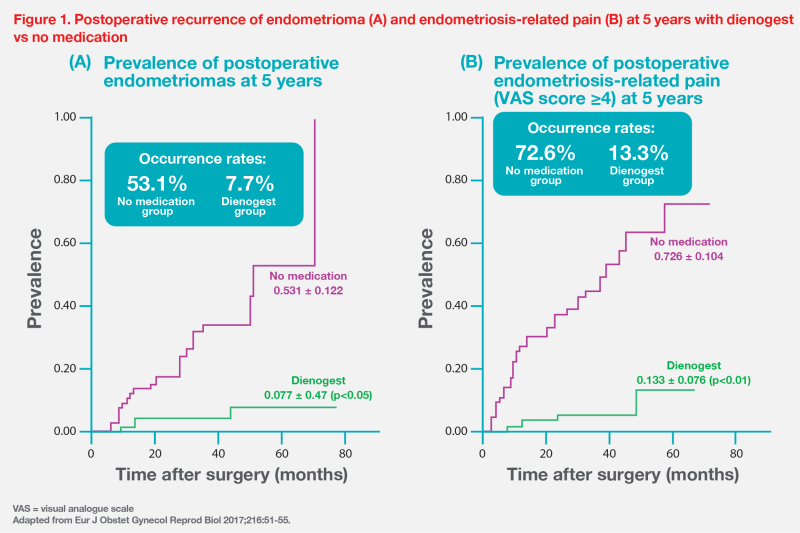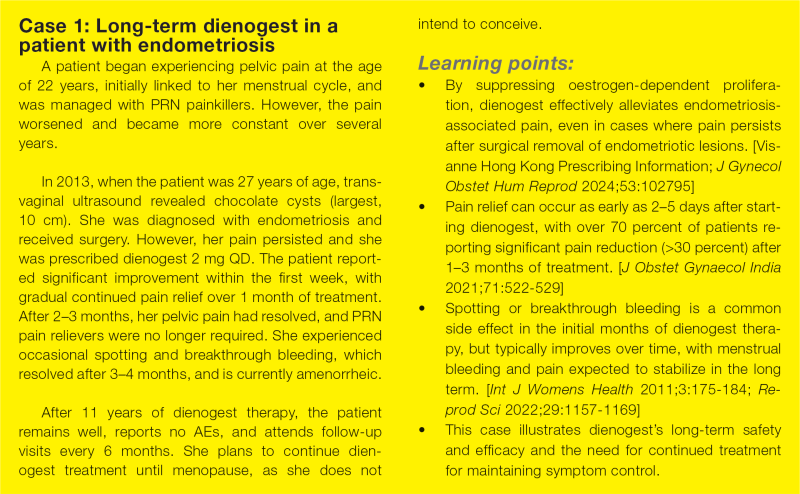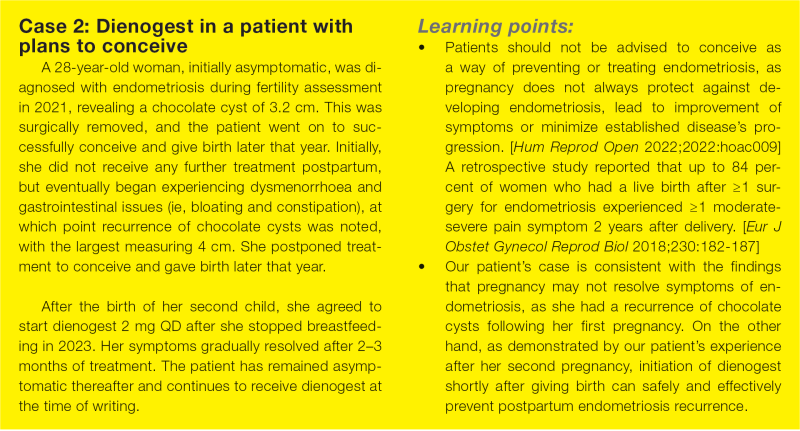Long-term oral progestogen therapy effective, well tolerated in endometriosis management





Endometriosis is a chronic disease, which requires interventions that are both effective and well tolerated in the long term. Dr Tak-Keung Sum, Specialist in Obstetrics and Gynaecology in private practice in Hong Kong, reviews clinical and real-world evidence on the long-term efficacy and safety of an oral progestogen, dienogest (Visanne®, Bayer), and shares his personal experience in managing endometriosis across different patient profiles.
Burden of endometriosis
Endometriosis is a chronic gynaecological condition characterized by the presence of ectopic endometrial-like tissue, which causes pain and may affect fertility. It typically requires continuous management until menopause. [Fertil Steril 2014;101:927-935] The type of treatment depends on the individual’s symptoms and preferences, as well as treatment availability, cost, efficacy, and tolerability. [Hum Reprod Open 2022;doi:10.1093/hropen/hoac009]
Chronic pain
Endometriosis causes debilitating chronic pain in the abdominopelvic region and may also manifest as dysmenorrhoea and dyspareunia. Chronic inflammation process involving growth factors and cytokines released by endometriotic implants, active bleeding, and irritation of pelvic floor nerves can sensitize the nervous system and result in a broader spectrum of pain experiences. [Fertil Steril 2014;101:927-935]
Infertility
Endometriosis may severely impact fertility and increase the need for assisted reproductive technologies. While surgery may be considered in certain cases, its risks and benefits should be carefully considered, especially in patients desiring fertility preservation. [Lancet 2004;364:1789-1799]
Recurrence after surgery
Postoperative recurrence rates of endometriosis have been estimated to be 21.5 percent at 2 years and up to 50 percent at 5 years. Although surgery may provide immediate pain relief, some clinicians now prefer to delay surgery for as long as possible due to the associated high risk of recurrence. [Nat Rev Endocrinol 2019;15:666-682; Int J Womens Health 2011;3:175-184; Fertil Steril 2015;104:793-801; Hum Reprod Update 2009;15:441-461]
Poor QoL
“The debilitating effects of chronic pain, the threat to reproductive health, as well as the need for repeat surgeries and long-term interventions to prevent or minimize recurrences take a substantial toll on patients with endometriosis in terms of their well-being, personal relationships, finances, and work productivity, negatively affecting their quality of life [QoL],” shared Sum. [Int J Womens Health 2011;3:175-184; Lancet 2004;364:1789-1799]
Long-term medical management for endometriosis
Medical treatment with progestogens (ie, progestins) such as dienogest or oral contraceptive pills is the first-line therapeutic option for patients with pelvic pain and no desire for immediate pregnancy. [Fertil Steril 2014;101:927-935; Fertil Steril 2015;104:793-801; Nat Rev Endocrinol 2019;15:666-682]
The European Society of Human Reproduction and Embryology (ESHRE) guidelines strongly recommend progestogens for reduction of endometriosis-associated pain, with particular consideration of individual agents’ side effect profiles. There is also a strong recommendation for clinicians to offer long-term hormone treatment after surgical management of ovarian endometrioma in women not immediately seeking conception. [Hum Reprod Open 2022;2022:hoac009]
Efficacy and safety data of dienogest
Dienogest, an oral progestin available in 2 mg tablets, is approved for management of endometriosis. [Visanne Hong Kong Prescribing Information] “Robust data support its efficacy and safety in women with endometriosis in terms of pain reduction and recurrence prevention, including after surgical interventions,” said Sum.
Pain relief and QoL improvement
“The efficacy of dienogest in providing pain relief for patients with endometriosis has been demonstrated in several clinical studies, including in Asian populations, as reflected in our patients’ experience,” Sum noted. (Cases 1 and 2)
A randomized, double-blind, placebo-controlled phase III study assessed dienogest 2 mg QD in 255 Chinese women aged 18–45 years with laparoscopically diagnosed endometriosis. After 24 weeks of treatment, the difference between the dienogest and placebo arms for mean reduction in endometriosis-associated pelvic pain (EAPP) was statistically significant in favour of dienogest (-24.54 mm; p<0.0001). Dienogest was well tolerated, with minimal adverse events (AEs) and no impact on bone mineral density after 24 weeks of treatment. [J Womens Health (Larchmt) 2018;27:148-155]
The multicentre, prospective ENVISIOeN study demonstrated that dienogest significantly improved the QoL of Asian women with endometriosis. Results showed decreased Endometriosis Health Profile-30 (EHP-30) scores across all domains, indicating improvement in health-related QoL. The pain domain was improved in 78.4 percent of patients, with a mean pain score decrease of 4.5 points. At the same time, 31.5 percent of patients experienced treatment-emergent AEs, where amenorrhoea (5.9 percent) and metrorrhagia (5.1 percent) were the most common events. [BMC Womens Health 2019;19:68]
Other clinical studies have demonstrated consistent efficacy results in favour of dienogest in relieving EAPP vs placebo, as well as comparable efficacy but better tolerability vs gonadotropin-releasing hormone agonists. [Eur J Obstet Gynecol Reprod Biol 2010;151:193-198; Hum Reprod 2010;25:633-641; Gynecol Endocrinol 2021;37:930-933]
Fertility preservation
Endometriomas, which are common in endometriosis, can adversely affect fertility, but its surgical removal may decrease ovarian reserve. A retrospective study of 116 women found that dienogest-based therapy significantly reduced endometrioma volume after 12 months vs controls (p<0.0001), with a notable decrease in cyst size and higher rates of cyst disappearance in those receiving dienogest alone vs dienogest plus ethinylestradiol. [Gynecol Endocrinol 2020;36:545-549]
Similarly, an observational study involving 157 patients indicated that long-term dienogest use (up to 9 years) reduced endometrioma size from a mean of 33.2 mm to 7 mm, while also alleviating various pain symptoms in patients with chronic EAPP. However, prolonged use was linked to increased AEs, including menstrual changes and osteopenia, necessitating careful monitoring. [Arch Gynecol Obstet 2024;309:589-597]
“These results suggest that dienogest-based therapy effectively controls endometrioma growth and may reduce need for surgery, which may be important in preserving fertility for patients with endometriosis, such as the patient described in Case 2,” said Sum. [Gynecol Endocrinol 2020;36:545-549; Arch Gynecol Obstet 2024;309:589-597]
For women with endometriosis who wish to get pregnant after achieving sufficient pain relief, current evidence indicates that the menstrual cycle returns to normal within 2 months after stopping dienogest. This suggests that dienogest is an effective option for managing endometriomas while preserving fertility potential in affected women, as demonstrated in Case 2. [Int J Womens Health 2011;3:175-184; Jpn Pharmacol Ther 2007;35:769-783; J Obstet Gynaecol Res 2009;35:1069-1076; Arch Gynecol Obstet 2012;285:167-173; Visanne Hong Kong Prescribing Information]
Prevention of postoperative recurrence
A retrospective study with approximately 2.5 years of follow-up included 126 patients with deep infiltrating endometriosis who underwent laparoscopic resection of uterosacral ligaments, followed by postoperative administration of dienogest or no medication. At 5 years, the prevalence of postoperative recurrence of endometriomas was lower with dienogest vs no medication (0.531 vs 0.077; p<0.05), as was the prevalence of postoperative endometriosis-related symptoms (0.726 vs 0.133; p<0.01). (Figure 1) [Eur J Obstet Gynecol Reprod Biol 2017;216:51-55]

Similar results were shown in several retrospective studies as well as a meta-analysis, supporting the role of prolonged daily administration of dienogest 2 mg after surgery in preventing recurrence of endometriosis and its associated symptoms. [J Endometr Pelvic Pain Disord 2015;7:63-67; Reprod Sci 2018;25:341-346; J Minim Invasive Gynecol 2020;27:1503-1510]
Long-term, real-world safety data with dienogest
The long-term safety of dienogest has been confirmed in VIPOS, the largest real-world observational study to date involving over 27,000 women with endometriosis across six European countries. Among these, 3,262 women started dienogest 2 mg daily either at study entry or during follow-up. A total of 798 women were long-term dienogest users (ie, continuous treatment for ≥15 months). [Adv Ther 2020;37:2528-2537; Eur J Obstet Gynecol Reprod Biol 2020;251:212-217; J Endometr Pelvic Pain Disord 2021;13:104-110]
In total, 180 serious AEs (SAEs) were reported in 4,482 women-years (WY); most were unplanned hospital admissions due to various reasons. Results showed no significant difference in SAEs between long-term and short-term dienogest users, with SAE incidence rates of 367.7 and 416.4 per 10,000 WY, respectively. While SAE incidence was higher among long-term users of dienogest vs long-term users of combined hormonal contraceptives (194.4/10,000 WY), it was lower compared with long-term users of other progestins (469.4/10,000WY). [J Endometr Pelvic Pain Disord 2021;13:104-110]
Additionally, VIPOS compared dienogest’s safety with other hormonal endometriosis treatments in terms of depression and anaemia. At baseline, dienogest users more frequently reported a surgically confirmed endometriosis diagnosis, severe endometriosis-associated pain and a history of depression vs other cohorts. No safety signal for anaemia was detected in dienogest users, with adjusted hazard ratio (HR) of 1.1 for dienogest vs other approved endometriosis drugs (OAEDs) and 1.3 vs other not approved but frequently used endometriosis drugs (NAEDs). The adjusted HRs for new or worsening depression were 1.8 for dienogest vs OAEDs and 1.5 for dienogest vs NAEDs. The researchers noted that a slight increase in depression risk could not be excluded but might be explained by baseline severity of endometriosis in dienogest users. [Eur J Obstet Gynecol Reprod Biol 2020;251:212-217]
Summary
Endometriosis is a chronic condition requiring long-term treatment. Long-term use of dienogest has demonstrated efficacy and safety in both clinical and real-world studies. Benefits of dienogest therapy include reduction of endometriosis-associated pain, prevention of symptom recurrence after surgery, and reduction in endometrioma size, as well as the possibility of prompt return to fertility following discontinuation, if desired.

